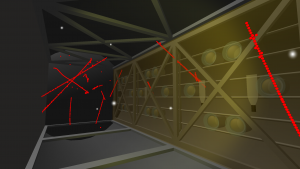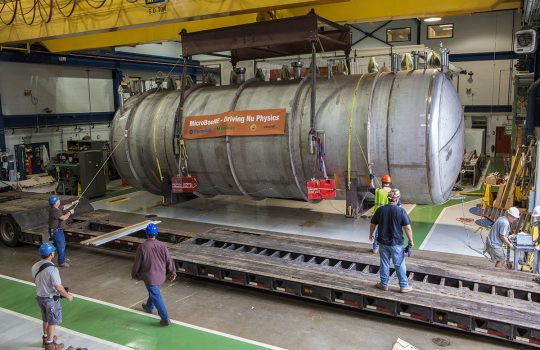
VENu lets you view real tracks left in the MicroBooNE neutrino detector. Image courtesy of Marco Del Tutto
What happens when tiny, invisible particles called neutrinos are sent hurtling through a tank of liquid argon? For most of the neutrinos, not much. They’ll pass through the argon unscathed. But other neutrinos will collide with argon molecules, leaving behind tracks — proof they were there.
These kinds of collisions take place inside Fermilab’s MicroBooNE neutrino detector. Now, with the help of VENu, a free smartphone app, users can dive into MicroBooNE’s 170-ton tank of liquid argon and see neutrino tracks for themselves.
“The primary goal of the VENu app is to get more people involved in particle physics, especially in neutrino physics,” said Marco Del Tutto, the app’s primary developer from Oxford University who works on the MicroBooNE experiment. “The app enables users to immerse themselves inside our particle detector and to see with their own eyes the particles that interact in it.”
VENu uses real data collected by the MicroBooNE neutrino detector, modeled in a 3-D environment to create an interactive neutrino-hunting experience. A game mode helps users understand what’s happening in the detector — what’s going on when a neutrino interacts with argon? — and then lets them catch the neutrino interactions themselves. VENu can also be used with any virtual-reality headset for an even more immersive experience.

VENu is compatible with personal virtual-reality devices, allowing for a portable, immersive experience. Photo courtesy of Marco Del Tutto
The development of VENu started in 2014, as the MicroBooNE team prepared to bring the detector online.
“We had been thinking about new ways to show off the MicroBooNE experiment. MicroBooNE is an innovative technology, and we wanted an innovative way to show it off,” said Sam Zeller, co-spokesperson of the MicroBooNE experiment.
Alistair McLean, a student from New Mexico State University, was the first to create a virtual model of the MicroBooNE detector, forming an important platform for a new way to visualize particle physics.
Del Tutto took VENu’s design a step further to make it more accessible for everyone.
“Many people hear ‘particle physics’ and think it’s too secretive and too hard for them to understand,” Del Tutto said. “An app looked like the perfect product, as it shares what we are doing, who we are, and shows real data, all in a simple and intuitive way.”
MicroBooNE isn’t the only particle physics experiment to have an app — Del Tutto is also a part of the team that made Collider, an app for the ATLAS experiment at CERN laboratory in Switzerland — but VENu is uniquely engaging.
“There aren’t many apps out there that combine real particle events and visualizations, learning sections and games to engage the public,” Del Tutto said.
In the future, Del Tutto plans to add visualizations of more detectors to the app, including ICARUS, a much larger neutrino detector than MicroBooNE. ICARUS is currently on its way to Fermilab from CERN. But for now, VENu will continue to showcase the MicroBooNE detector.
Zeller said, “We are very proud of where VENu started, what it has become and the possibility to show off MicroBooNE in a completely new way.”



